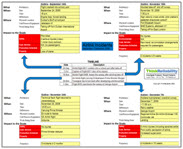On February 12, 2010 at approximately 10:13 A.M., a six-car Red Line Metro train taking passengers to Shady Grove derailed near the Farragut North station in Washington, D.C. If you’ve been reading our blog, you’ve seen our reports on three previous Metro incidents in the past year (two Metro workers were killed in January, two trains collided last November, and two trains also collided last June).
Thankfully, this derailment caused only minor injuries. However, it did result in an extremely messy commute for a lot of people, due to a severe delay in train service. Additionally, there was likely damage to the train and/or track, which will require labor to repair. More labor will be required for the investigation.
All the basic information, as well as the impacts to the goals (the injuries, delay in service, property damage and labor required as a result of the incident), relating to this event are captured in a problem outline. We can also capture anything that was different at the time. Here we note that there were major storms in the area and that the commute was especially heavy.
 Once we have completed the outline, we can begin the Cause Map with the goals that were impacted. The impacts to the goals resulted from the train derailing. The train derailed when the front wheels slipped and the lead car came off the track. Metro and National Transportation Safety Board (NTSB) investigators are determining the causes of the derailment, but some of the things that will be looked at as causes include: the train was moving onto a pocket track. Other trains previously have slipped off the track while moving onto a pocket track (a side track that allows trains to pass other trains or move around construction). It’s unclear whether the train was moving onto the pocket track to move around other trains or track work.
Once we have completed the outline, we can begin the Cause Map with the goals that were impacted. The impacts to the goals resulted from the train derailing. The train derailed when the front wheels slipped and the lead car came off the track. Metro and National Transportation Safety Board (NTSB) investigators are determining the causes of the derailment, but some of the things that will be looked at as causes include: the train was moving onto a pocket track. Other trains previously have slipped off the track while moving onto a pocket track (a side track that allows trains to pass other trains or move around construction). It’s unclear whether the train was moving onto the pocket track to move around other trains or track work.
As previously mentioned, the snow and icy conditions (which have been extreme as of late in D.C.) may have caused the tracks to be slippery, which potentially contributed to the derailment. It’s possible there was damage to the tracks or switch, as the area where the derailment took place is the oldest portion of the Red Line, and is due for maintenance. Because of an extreme budget shortfall on the Metro line, repairs to tracks and cars have been delayed. Last but not least, there’s a possibility that the weight of the rail car may have been a factor in the derailment. The cars were extremely crowded because of an insufficient number for the commute. Metro was not running the normal number of cars because it had not completely recovered from the storm, but there were the normal number of commuters because the Federal Government was open. (The Federal Government usually remains closed when the Metro system is unable to run at full capacity.)
Even though we are not yet certain which factors may have contributed to the derailment, we can include them all on the Cause Map until we are able to rule some of them out. Even more detail can be added to this Cause Map as the analysis continues. As with any investigation the level of detail in the analysis is based on the impact of the incident on the organization’s overall goals. View the beginning stage of the root cause analysis investigation by clicking on “Download PDF” above.




 After we’ve completed the outline, we build our Cause Map beginning with the goals that were impacted. The goals were impacted by a series of explosions and fires across the ship. These explosions and fires were fueled by jet fuel and bombs that were found on the planes on the flight deck of the carrier. The initiating event was the explosion of a Mk-32 Zuni rocket, which exploded when it overheated due to being put in the exhaust path of an aircraft starting unit.
After we’ve completed the outline, we build our Cause Map beginning with the goals that were impacted. The goals were impacted by a series of explosions and fires across the ship. These explosions and fires were fueled by jet fuel and bombs that were found on the planes on the flight deck of the carrier. The initiating event was the explosion of a Mk-32 Zuni rocket, which exploded when it overheated due to being put in the exhaust path of an aircraft starting unit.


